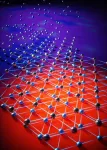(Press-News.org) QUT researchers have developed a new machine learning mathematical system that helps to identify and detect changes in biodiversity, including land clearing, when satellite imagery is obstructed by clouds.
Using statistical methods to quantify uncertainty, the research, published in Remote Sensing in Ecology and Conservation, analysed available satellite images of an 180km square area in central south-east Queensland.
The region is home to many native species including the critically endangered northern hairy-nosed wombat and the vulnerable greater glider, and the area mainly consists of forest, pasture, and agricultural land.
Dr Jacinta Holloway-Brown says measuring changes in forest cover over time is essential to track and preserve habitats and is a key sustainable development goal by the United Nations and World Bank to manage forests sustainably.
"Satellite imagery is important as it is too difficult and expensive to frequently collect field data over large, forested areas," Dr Holloway-Brown said.
"The problem with using satellite imagery is large portions of the earth are obscured by clouds and this cloud cover causes large and frequent amounts of missing data."
Dr Holloway-Brown said it was estimated based on 12 years of satellite imagery on average approximately 67 per cent of the earth is obscured by cloud cover.
"Using our method, we can compare pixel by pixel what type of land cover there is and if it has changed since the last image. For example, if the pixel was forest in the last image and in the next a week or so later it has changed to soil or a tree stump, we are able to detect that," she said.
The research involved calculating two simulated types of clearing events, clear felling which involves removing all trees from the area and burning to prepare for future growth and, secondly, tree thinning which involves only removing trees from the area, leaving smaller shrubs, grassland, and pasture behind.
By simulating clouds, the researchers, which includes QUT's Distinguished Professor Kerrie Mengersen and Dr Kate Helmstedt, could "test the limits" of the method and know how well or not it could predict what was underneath the clouds.
The results showed the method accurately detected simulated land cover change under both clear felling and tree thinning.
"We get the most up to date predictions of missing data due to clouds by training our machine learning method at the edges of those clouds and predicting the missing areas," she said.
Dr Holloway-Brown is due to present the research to the United Nations Task Team on Earth Observation Data.
"There are real possibilities to use our method to make a real difference to forest monitoring," she said.
INFORMATION:
The researchers are part of the QUT-based Australian Research Council Centre of Excellence for Mathematical and Statistical Frontiers.
Fossilized feces are common finds at paleontological dig sites and might actually contain hidden treasures. By scanning fossilized dung assigned to a close dinosaur relative from the Triassic period, scientists discovered a 230-million-year-old beetle species, representing a new family of beetles, previously unknown to science. The beetles were preserved in a 3D state with their legs and antennae fully intact. The finding appears June 30 in the journal Current Biology.
The discovery that fossilized droppings, also known as coprolites, can preserve ancient insect species offers a new alternative to amber fossils--fossilized tree resin, which normally yield the best-preserved insect fossils. The oldest ...
Don't let the great snipe's pudginess fool you. A stocky marsh bird with a 20-inch wingspan, great snipes are also speedy marathoners that can migrate from Sweden to Central Africa in just three days, without even stopping to eat, drink, or sleep. Now, researchers find that the snipes also rise nearly 2,500 meters in elevation at dawn and descend again at dusk each day, perhaps to avoid overheating from daytime solar radiation by climbing to higher, cooler altitudes. The findings appear June 30 in the journal Current Biology.
The birds also spent much more time in higher elevations ...
Election outcomes are notoriously difficult to predict. In 2016, for example, most polls suggested that Hillary Clinton would win the presidency, but Donald Trump defeated her. Researchers cite multiple explanations for the unreliability in election forecasts -- some voters are difficult to reach, and some may wish to remain hidden. Among those who do respond to surveys, some may change their minds after being polled, while others may be embarrassed or afraid to report their true intentions.
In a new perspective piece for END ...
30 June 2021: A large cohort study drawn from the national IVF registry of France, which included almost 70,000 pregnancies delivered after 22 weeks gestation between 2013 and 2018, has found a higher risk of pre-eclampsia and hypertension in pregnancies derived from frozen-thawed embryos. This risk was found significantly greater in those treatments in which the uterus was prepared for implantation with hormone replacement therapies. The results confirm with real-life data what has been observed in sub-groups of patients in other studies.
The results are presented today by Dr Sylvie Epelboin from the Hôpital Bichat-Claude Bernard, Paris, at the online annual meeting of ESHRE. The study was performed on behalf ...
The tiny beetle Triamyxa coprolithica is the first-ever insect to be described from fossil faeces. The animal the researchers have to thank for the excellent preservation was probably the dinosaur ancestor Silesaurus opolensis, which 230 million years ago ingested the small beetle in large numbers.
In a recently published study in Current Biology, vertebrate palaeontologists from Uppsala University and entomologists from National Sun Yat-sen University (Taiwan), Friedrich-Schiller-Universität Jena (Germany), and Universidad de Guadalajara (Mexico) used synchrotron microtomography to 3D-reconstruct the beetles while they were still trapped within the fossilised faecal matter. The coprolite contained abundant beetle body parts, most belonging to ...
Harpy eagles (Harpia harpyja) - which are among the world's largest eagle species - struggle to feed offspring in heavily deforested areas of the Amazon, according to a study published in Scientific Reports.
Everton Miranda and colleagues found that harpy eagles rely on specific prey that lives in canopy forests, including sloths and monkeys. Eaglets starved in areas of high deforestation where canopy-based food was limited.
The authors observed prey species, how frequently prey was delivered, and estimated the weight of prey in 16 harpy eagle nests in Amazonian forests in Mato ...
ROCKVILLE, MD, USA - June 30, 2021 - Researchers from Sanaria® Inc. and the National Institutes of Health (NIH) are making progress in the development of highly protective malaria vaccines.
In an article published today in Nature, Sanaria's PfSPZ-CVac (CQ) vaccine is reported as being safe and protecting 100% of six subjects against a variant malaria parasite three months after their last dose in the company's Phase 1 safety and efficacy trial. This is the first time complete protection against a variant malaria parasite has ever been achieved that long after vaccine administration.
The ...
Many neurodevelopmental disorders share similar symptoms, such as learning disabilities or attention deficits. A new study from MIT has uncovered a common neural mechanism for a type of cognitive impairment seen in some people with autism and schizophrenia, even though the genetic variations that produce the impairments are different for each condition.
In a study of mice, the researchers found that certain genes that are mutated or missing in some people with those disorders cause similar dysfunctions in a neural circuit in the thalamus. If scientists could develop drugs that target this circuit, they could be used to treat people who have different disorders with common behavioral ...
In 1934, physicist Eugene Wigner made a theoretical prediction based on quantum mechanics that for 87 years went unseen.
The theory suggested how a metal that normally conducts electricity could turn into a nonconducting insulator when the density of electrons is reduced. Wigner theorized that when electrons in metals are brought to ultracold temperatures, these electrons would be frozen in their tracks and form a rigid, non-electricity conducting structure -- a crystal -- instead of zipping around at thousands of kilometers per second and creating an electric current. Since he discovered it, the ...
Researchers have found that eating disorder behaviors, such as binge-eating, alter the brain's reward response process and food intake control circuitry, which can reinforce these behaviors. Understanding how eating disorder behaviors and neurobiology interact can shed light on why these disorders often become chronic and could aid in the future development of treatments. The study, published in JAMA Psychiatry, was supported by the National Institutes of Health.
"This work is significant because it links biological and behavioral factors that interact to adversely impact eating behaviors," said Janani Prabhakar, ...



